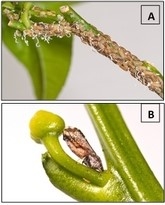Asian Citrus Psyllid Update
Winter and spring rains have given us a robust growing season this year. Tender new citrus flush is ideal habitat for ACP to feed, lay eggs and build new populations. An increase in ACP numbers and feeding can increase the risk of HLB spreading and building up. University of California recommends growers monitor trees regularly for ACP, paying careful attention to new flush, and treat when populations reach the detection threshold. The UC IPM website lists a range of materials effective against ACP, including organic options. Growers are also encouraged to work with a pest management professional to better detect and manage ACP.
Advanced notification of nearby beekeepers is required before pesticide treatments. Use the BeeWhere BeeCheck system, or contact the County Agricultural Commissioner's office, 805-681-5600, for more information. Always follow label instructions for bee safety.
If your citrus is no longer being cared for or is not worth the resources required to protect it from ACP and HLB, consider removing it.
HLB Quarantine Update
As of May 5, a total of 5.007 trees and 709 ACP have been confirmed positive for the bacterium that causes HLB. Trees confirmed positive are treated for ACP and removed, and the HLB quarantine may be expanded. Additional ACP treatments and HLB detection surveys are conducted on a recurring basis to remaining citrus within 250 meters of each detection.
Counties where HLB has been detected via PCR testing are Los Angeles, Orange, San Diego, Riverside, San Bernardino and San Diego, with the majority of detections in Orange County. To see a map of the current HLB quarantine areas, and other details of locations and numbers of HLB detections, please visit maps.cdfa.ca.gov/WeeklyACPMaps/HLBWeb/HLB_Treatments.pdf.
HLB Detection Response Guide for Growers
To ensure California citrus growers are well prepared in the event of a potential commercial grove detection of Huanglongbing (HLB), the Citrus Pest and Disease Prevention Program (CPDPP) has developed the Response Guide for a Confirmed HLB Positive Detection in a Commercial Grove, which details the steps taken by CDFA and actions required of the property or grove owner, as outlined in CDFA's Action Plan and Information for Citrus Growers/Grove Managers.
Citrus Pest and Disease Prevention Committee Meetings -- Webinar and In Person
All meeting agendas and eventually the minutes are posted at www.cdfa.ca.gov/citrus committee/. The 2022-23 schedule for the Full Committee is here, and the schedule for Subcommittees is here.
Upcoming Meetings
- Operations Subcommittee, Wednesday May 10 at 9 am (agenda and webinar link)
- Outreach Subcommittee, Wednesday May 10 at 1:30 pm (agenda and webinar link)
- CPDPP Full Committee, Wednesday August 9 (agenda pending)
All meetings are free and open to the public to listen to or make public comment. Meetings are currently in person and accessible via phone and/or webinar. Links to register for and join meetings are included in agendas when posted.
For a list of current committee members, click here.
Additional ACP/HLB Resources
- CDFA Citrus Division website: https://www.cdfa.ca.gov/Citrus/
- General ACP/HLB
oInformation on the state ACP/HLB program including maps, quarantine information, and a signup option for email alerts: citrusinsider.org/
oBiology of ACP and HLB, detection maps and recommendations for monitoring, eradication and management: ucanr.edu/sites/acp/
oUC IPM recommendations for ACP insecticides
oWeb-based map to find out how close you are to HLB: ucanr.edu/hlbgrowerapp
oVideo on Best Practices in the Field, available in English and Spanish
oSpanish-only ACP/HLB presentation video presentation and audio-only recording.
- Research
oLatest Science Advisory Panel Report
oUC Ag Experts Talk presentations on management of various citrus pests and diseases are available for viewing here and here on YouTube.
oSummaries of the latest research to combat HLB: ucanr.edu/sites/scienceforcitrushealth/
oScience-based analyses to guide policy decisions, logistics, and operations: www.datoc.us
- Regulatory/Quarantine
oSign up for program updates from the Citrus Pest and Disease Prevention Division at www.cdfa/signup-email-updates.
oRegulatory requirements for moving bulk citrus: Information for Citrus Growers
oSummary of regulatory requirements in the event of an HLB detection in commercial citrus: citrusinsider.org/Regulatory-Flyer
oSanta Barbara County Ag Commissioner's Office
--------
Cressida Silvers
CA Citrus Pest and Disease Prevention Program
ACP/HLB Grower Liaison
Ventura, Santa Barbara and San Luis Obispo Counties
805 284-3310 (phone or text)
